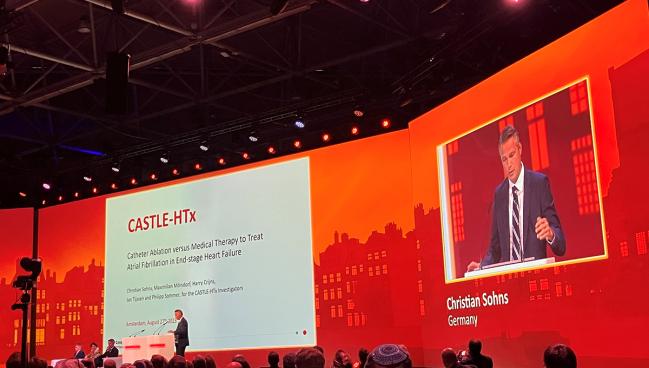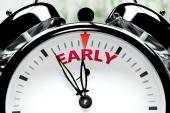CASTLE-HTx: AF Ablation Boosts Outcomes in Advanced Heart Failure
Despite some limitations, “the totality of evidence really points towards a benefit,” James Januzzi says.

AMSTERDAM, the Netherlands—Using catheter ablation to treat atrial fibrillation (AF) provides a benefit even among patients with advanced heart failure who are being considered for heart transplantation or implantation of left ventricular assist device (LVAD), results of the CASTLE-HTx trial show.
Though numbers of patients and events were relatively small, adding ablation to guideline-directed medical therapy (GDMT) significantly reduced a composite of all-cause death, implantation of an LVAD, or urgent heart transplantation through a median follow-up of about a year and a half (HR 0.24; 95% CI 0.11-0.52), Christian Sohns, MD (Herz- und Diabeteszentrum Nordrhein-Westfalen, Ruhr-Universität Bochum, Bad Oeynhausen, Germany), reported here at European Society of Cardiology Congress 2023.
That difference was driven by significant reductions in both death and LVAD implantation, with a favorable—but nonsignificant—trend in terms of heart transplantation. And the procedure was shown to be safe in this sick population.
“AF ablation . . . should be considered as part of the standard treatment options in advanced heart failure patients,” Philipp Sommer, MD (Herz- und Diabeteszentrum Nordrhein-Westfalen, Ruhr-Universität Bochum), lead author of the paper simultaneously published in the New England Journal of Medicine, said during a press conference. “AF ablation has beneficial effects on mortality during the so-called waiting time for patients that are planning to undergo transplant and prolongs the time span until surgical interventions will be necessary.”
Even though guidelines are not usually changed on the basis of a single RCT, Sommer said, “we think that the quality of the data is strong enough to affect guidelines.”
James Januzzi Jr, MD (Massachusetts General Hospital, Boston), commenting for TCTMD, noted some limitations of the trial, including the open-label design, the relatively small sample size (194 patients), and the fact that it was conducted at a single center, and he said that on its own, it is not enough to influence guidelines.
“But regardless of that fact,” said Januzzi, a member of the American College of Cardiology’s board of trustees, “the totality of evidence really points towards a benefit from catheter ablation in our most advanced patients with heart failure.”
And he credited the investigators with performing the trial in a challenging group of patients with relatively few treatment options. “Studying the role of catheter ablation in a patient population like this, quite honestly, was a bit of a brave move because this is a population previously resistant to improvement with other therapies,” Januzzi said.
CASTLE-HTx
Data from trials like CASTLE-AF, CABANA, and CAMERA-MRI have indicated that catheter ablation improves outcomes among patients with heart failure and symptomatic AF, but patients with end-stage heart failure have been excluded from prior studies. Thus, Sommer said, there have been questions about whether ablation is feasible, can reduce AF burden, and can improve LV function and clinical outcomes in patients with more-advanced heart failure.
CASTLE-HTx, conducted at a German center that has performed about 3,000 heart transplants since 1989, was designed to address those questions. Investigators enrolled 194 patients (mean age roughly 63.5 years; 81% men) who were being evaluated for heart transplantation or LVAD implantation and who had at least NYHA class II symptoms, an LVEF of 35% or less, and impaired functional capacity based on 6-minute walk test. All had an implanted cardiac device that allowed for continuous rhythm monitoring.
Patients were randomized to AF ablation plus GDMT or to GDMT alone and followed for a median of 18 months; the trial was stopped early for efficacy following a recommendation from the data and safety monitoring board. Ultimately, ablation was performed in 84% of patients initially assigned to undergo the procedure and 16% of patients in the control arm.
AF ablation has beneficial effects on mortality during the so-called waiting time for patients that are planning to undergo transplant and prolongs the time span until surgical interventions will be necessary. Philipp Sommer
The primary composite endpoint of all-cause death, LVAD implantation, or urgent heart transplantation occurred in 8% of patients in the ablation arm and 30% of those in the control, a significant difference driven primarily by reductions in all-cause death (6% vs 20%; HR 0.29; 95% CI 0.12-0.72) and LVAD implantation (1% vs 10%; HR 0.09; 95% CI 0.01-0.70). All but two of the deaths were attributed to cardiovascular causes.
Urgent heart transplantation also was less frequent in the ablation arm, although the difference did not reach statistical significance (1% vs 6%; HR 0.15; 95% CI 0.02-1.25).
To explain the observed benefits of ablation, the investigators point to a greater improvement in LVEF by 1 year (by 7.8% vs 1.4% in the control group) and a larger drop in AF burden (by 31.4% vs 8.6%).
In terms of safety, procedure-related complications occurred in three patients in the ablation arm and one in the control arm, all related to the vascular access site.
Eradicating Treatment ‘Nihilism’
Serving as a discussant following Sohns’ presentation, Finn Gustafsson, MD, PhD (Rigshospitalet – Copenhagen University Hospital, Denmark), noted that although AF is common in advanced heart failure, it has not been shown to have a strong impact on prognosis in patients with very low ejection fraction. A prior small trial did not show that ablation improved LVEF in patients with advanced heart failure and severe LV systolic dysfunction, and a subgroup analysis of CASTLE-AF indicated that patients with the lowest LVEFs derived less benefit from the procedure, he added.
“It’s safe to say that prior to CASTLE-HTx, there was little enthusiasm for ablation in patients with more-advanced heart failure,” Gustafsson said.
Now, CASTLE-HTx demonstrates an impressive reduction in total mortality, he said, adding, however, that there are limitations, some noted by Januzzi, and remaining questions. He pointed out that the trial population would not necessarily fulfill criteria for advanced heart failure laid out in guidelines and that the death rate after heart transplantation or LVAD implantation was higher than expected. In addition, he said, it’s unclear whether the improvement in outcomes is driven by the lowering of AF burden and whether the effect will persist.
Despite those questions, the trial, “if anything, helped eradicate the current somewhat nihilistic approach to atrial fibrillation management in patients with advanced heart failure,” Gustafsson said. And it shows, he added, that this group of patients “should be actually considered for ablation as it may prevent the need for heart transplant or LVAD implant. And that, of course, would be a huge achievement.”
Studying the role of catheter ablation in a patient population like this, quite honestly, was a bit of a brave move. James Januzzi
Januzzi noted that when a small study is terminated early, there is the potential for an exaggerated benefit. With CASTLE-HTx, he said, “the magnitude of benefit was substantially greater than what we often see in larger trials with more statistical powering.”
Still, the totality of the data indicates that ablation is having a positive effect, Januzzi said. “While one can be skeptical of the magnitude of effect, the signals are pointing in the right direction to suggest that in a larger, more-powered study, we would still see benefit, albeit perhaps with a less-robust hazard ratio.”
Overall, the findings suggest “that together with ongoing medical therapy and surveillance, catheter ablation certainly should be a consideration for patients across the wide spectrum of heart failure,” he concluded.
Todd Neale is the Associate News Editor for TCTMD and a Senior Medical Journalist. He got his start in journalism at …
Read Full BioSources
Sohns C, Fox H, Marrouche NF, et al. Catheter ablation in end-stage heart failure with atrial fibrillation. N Engl J Med. 2023;Epub ahead of print.
Disclosures
- CASTLE-HTx was funded by Else Kröner-Fresenius-Stiftung.
- Sohns reports a grant/research contract to his institution from Else Kröner-Fresenius-Stiftung.
- Sommer reports consulting for Abbott, Biosense Webster, Boston Scientific, and Medtronic.





Comments